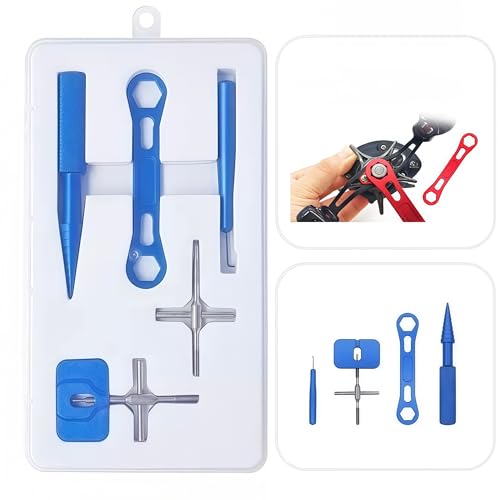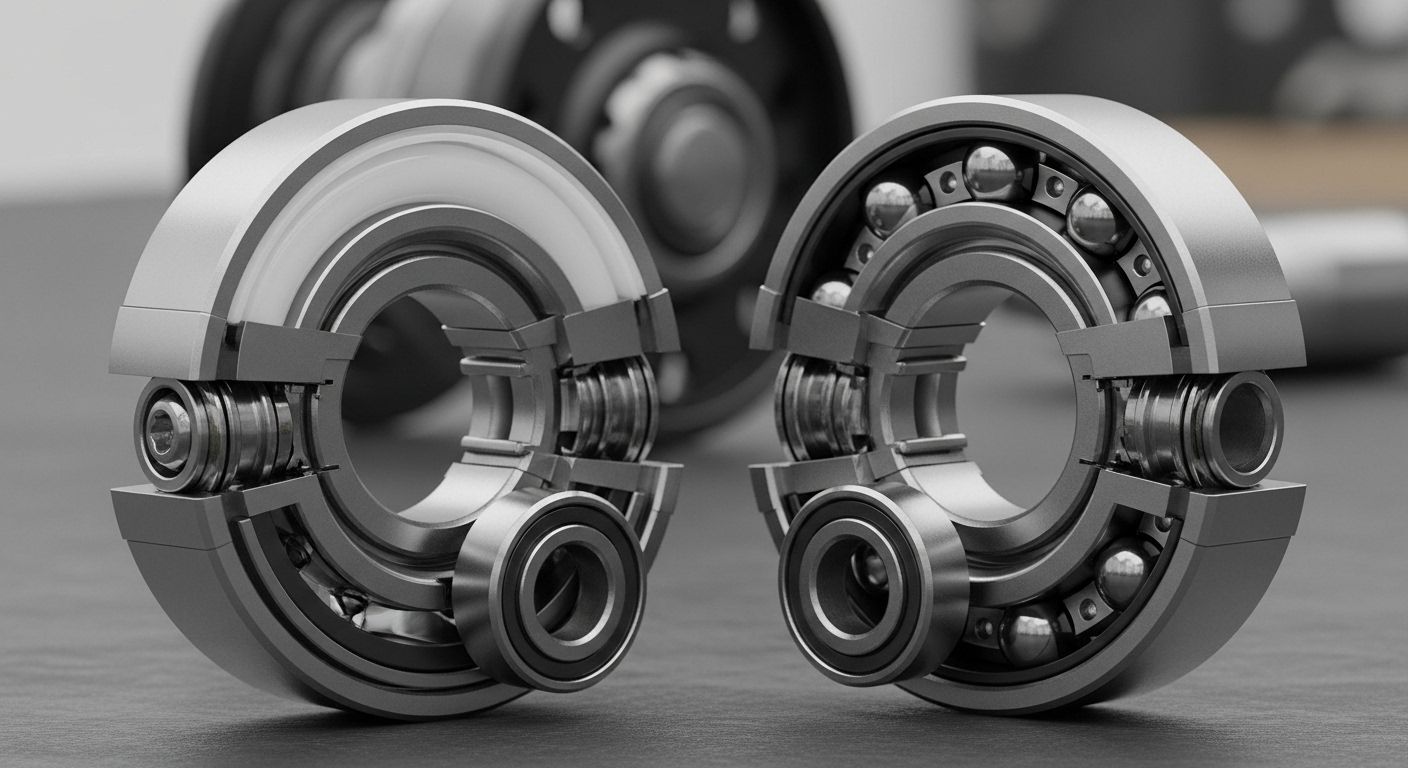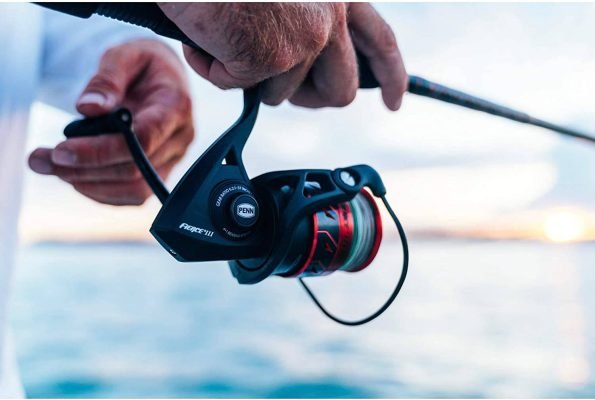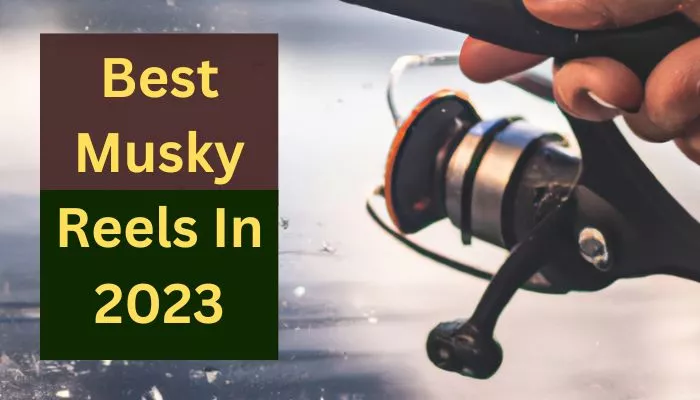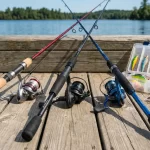That fishing reel in your tackle box? It’s not just a tool—it’s your silent partner in the eternal battle between angler and fish. But like any good relationship, it needs some TLC to keep things running smoothly.
Whether you’re rocking premium Shimano’s or that trusty Penn that’s been in your family for generations, proper maintenance isn’t just recommended—it’s essential.
Let’s dive into the world of fishing reel maintenance without the fluff. You’ll learn exactly how to keep your gear performing at its peak, extend its lifespan, and save yourself from that gut-punch moment when your reel seizes up just as the fish of a lifetime hits your line.
Interactive Reel Maintenance Guide
Click on different parts of the fishing reel to learn about maintenance procedures.
Drag System Maintenance
The drag system controls tension on your line when fighting fish. Proper maintenance ensures smooth, consistent performance.
- Back off drag completely before cleaning
- Clean washers with a non-petroleum cleaner
- Allow washers to dry completely
- Apply appropriate drag grease if recommended
- Test drag by pulling line while adjusting knob
Spool Cleaning & Maintenance
The spool holds your fishing line and is constantly exposed to water, salt, and debris.
- Remove the spool by unscrewing the drag knob
- Clean both sides thoroughly with fresh water
- Remove any salt deposits or sand with a soft brush
- Check for corrosion, especially underneath the spool
- Apply a thin layer of reel grease to the main shaft
Bail & Line Roller Maintenance
The bail and line roller are critical components that ensure smooth line retrieval and prevent line twisting.
- Remove the small screw holding the line roller
- Clean the roller with reel cleaner or white gas
- Clean the bail area where the roller sits
- Apply a single drop of lightweight oil to the bearing
- Check that the roller spins freely after reassembly
Handle & Knob Maintenance
The handle and knob see constant hand contact and movement, requiring regular attention.
- Remove the handle by unscrewing counterclockwise
- Clean the handle shaft and internal socket
- Check for corrosion or wear on the drive gear
- Apply a small amount of grease to the handle knob
- Ensure the handle is properly reattached
Reel Body & Gear Maintenance
The reel body houses critical gears and components that transfer power from the handle to the spool.
- Access gears by removing side plate screws
- Carefully clean gears with a soft brush
- Remove old grease and apply fresh reel grease
- Check for worn teeth or damaged components
- Reassemble carefully following manufacturer schematics
Why Reel Maintenance Matters More Than You Think
Your fishing reel is essentially a miniature precision machine with numerous moving parts working in harmony. When these components get gunked up with salt, sand, or debris, performance takes a nosedive faster than your lure hits the water.
The harsh reality? Saltwater is the number-one cause of seized reels and damaged components. Just a single saltwater fishing trip without proper aftercare can start the corrosion process. That $200 reel suddenly becomes an expensive paperweight.
Think of maintenance as preventative medicine. The small investment in time and supplies pays massive dividends:
- Extends reel life by years
- Maintains smooth drag performance when you need it most
- Ensures reliable casting distance and accuracy
- Prevents mid-fight failures (aka fish stories about “the one that got away”)
- Saves money on replacements and repairs
According to fishing experts with over 12 years in the tackle industry, most warranty claims for seized reels stem from inadequate maintenance rather than manufacturing defects. That’s right—it’s not the reel that failed, it’s the maintenance routine.
Essential Maintenance Tools: The Ultimate Fishing Reel Care Kit
Before diving into the how-to, let’s gear up with the right tools. Your fishing reel maintenance kit doesn’t need to be fancy, but it should be complete:
The Must-Haves:
- Small screwdrivers (Phillips and flathead) – for accessing internal components
- Reel cleaner/degreaser – white gas or specialized reel cleaner
- Reel oil – lightweight for bearings and fast-moving parts
- Reel grease – heavier lubricant for gears and load-bearing components
- Microfiber cloths – lint-free for cleaning without scratching
- Cotton swabs/Q-tips – for reaching tight spaces
- Small containers – to keep tiny parts organized during disassembly
- Soft toothbrush – for gentle cleaning of gears and hard-to-reach areas
- Your reel’s schematic (if available) – your roadmap for disassembly
Pro Upgrade Options:
- Ultrasonic cleaner – for deep cleaning without disassembly
- Compressed air – for blowing out sand and salt deposits
- Specialized tools from manufacturers like the Shimano fishing reel maintenance kit
Having these supplies ready before you start means you won’t leave your reel partially disassembled while running to the store—the mechanical equivalent of open-heart surgery with the patient left on the table.
The Post-Fishing Maintenance Ritual: Your Reel’s Survival Guide
The most critical maintenance happens immediately after your fishing trip. This quick 5-minute routine can prevent 90% of common reel problems, especially after saltwater exposure:
The Immediate Rinse Protocol
- Tighten your drag first – This prevents water from seeping into the drag stack and traveling down the main shaft
- Position your rod at a 45-degree angle – Start by hosing down the rod from tip to foregrip to remove salt deposits around the guides
- Stand back 1-2 meters – Gently mist your reel with fresh water (not pressure washing!)
- Rinse the spool and line – Run warm water over both to prevent corrosion underneath the spool and maintain line condition
- Dry thoroughly – Use a clean cloth to remove remaining moisture and salt deposits
This isn’t just good advice—it’s survival gear for your equipment. Fishing tackle experts recommend this rinse after every saltwater outing, no exceptions. Even freshwater fishing requires a quick rinse to remove dirt and debris that can become abrasive inside your reel.
Deep Cleaning: Taking Your Reel Apart (Without Destroying It)
Sometimes that quick rinse isn’t enough, and your reel needs deeper attention. Here’s how to approach a thorough cleaning without turning your pride and joy into a pile of parts:
Before You Start: The Golden Rules
- Work in a clean, well-lit area
- Keep track of all parts (a segmented container works wonders)
- Take photos of each step if you’re new to this
- Don’t force anything that doesn’t want to move
- Have your reel’s schematic handy if possible
Spinning Reel Disassembly Process
- Handle removal:
- For bolt-secured handles: Remove the bolt cap opposite the handle, then slide it free
- For screw-secured handles: Hold the reel while rotating the handle backward toward yourself
- Spool removal:
- Turn the drag knob counterclockwise until it comes off
- Lift the spool straight up and off the reel body
- Note any adjustment washers underneath—they must return to their exact position
- Side plate and gear access (for conventional reels):
- Remove the small screws holding the side plate to the reel body
- Carefully lift the side plate without dislodging internal gears
- Important: Don’t remove gears manually—they have high tolerances and can be difficult to realign
Cleaning Process
- Wipe down all external surfaces with a damp cloth
- Use Q-tips and a reel cleaner for hard-to-reach areas
- Pay special attention to the bail and line roller assembly (more on this later)
- Allow components to dry completely before lubrication and reassembly
For specific reel types like Abu Garcia Revo models, access the gear system by:
- Removing the two torque screws (one on the front of the stem, one on the bottom rear cap)
- The butt cap will then come off for easy access to internal workings
The Art of Lubrication: Where and What to Apply
Lubrication is where many anglers go wrong—either by using the wrong product, applying too much, or missing crucial components. Here’s how to do it right:
Types of Lubricants and Their Purpose
| Lubricant Type | Best For | Application Points | Common Mistakes |
|---|---|---|---|
| Lightweight Oil | Fast-moving parts | Gears, spool shafts, and bail mechanisms | Using too much, which attracts dirt |
| Reel Grease | Load-bearing components | Gears, spool shafts, bail mechanisms | Using petroleum-based products that can damage seals |
Application Guide: Less is More
The cardinal rule of reel lubrication? Apply sparingly. A single oil drop or a pea-sized grease is usually sufficient. Excess lubricant will:
- Attract dirt and debris
- May affect drag performance
- Can damage the line and other components
Lubrication Points Checklist
✓ Main gear – Light coating of grease
✓ Pinion gear – Light coating of grease
✓ Line roller – Single drop of oil
✓ Bail arm pivots – Drop of oil at connection points
✓ Handle knob – Small amount of grease
✓ Spool shaft – Light coating of grease
✓ Oscillation mechanism – Light oil for sliding parts
✓ Clutch system – Drop of oil (check manufacturer recommendations first)
Remember that different reel components require different types of lubricants. Be wary of petroleum-based products as these can thin out grease and potentially damage rubber components, O-rings, and seals.
Component-Specific Maintenance: The Critical Parts
Bail and Line Roller Maintenance
The bail and line roller assembly deserves special attention—it’s constantly exposed to water, salt, and debris:
- Carefully remove the small screw holding the line roller in place (note orientation)
- Clean the roller thoroughly using a reel cleaner or white gas
- Clean the bail area where the roller sits using a Q-tip
- Apply a single drop of oil to the bearing before reassembly
- Check that the roller spins freely after reinstallation
The bail spring assembly often collects sand and salt. Clean this thoroughly with special attention to the spring mechanism to ensure smooth operation.
Drag System Care
Your reel’s drag system prevents your line from breaking when fighting a fish. Proper maintenance ensures consistent, smooth performance:
- Clean drag washers with a non-petroleum cleaner
- Allow to dry completely
- Apply appropriate drag grease if recommended by the manufacturer
- Ensure washers are properly seated during reassembly
- Test drag by pulling line while adjusting the drag knob
Pro tip: Always back off your drag completely before storage. Leaving the drag tight will compress the washers and create a “lumpy” drag performance.
Maintenance Schedule: How Often Should You Service Your Reels?
The frequency of maintenance depends on your fishing habits and conditions:
| Usage Pattern | Basic Rinse | Deep Clean & Lube | Professional Service |
|---|---|---|---|
| After saltwater use | Immediately | Every 3-5 trips | Annually |
| Weekly freshwater angler | After each use | Every 10-15 trips | Every 1-2 years |
| Occasional angler | After each use | Every 5-8 trips | Every 2-3 years |
| Tournament angler | After each use | Monthly | Every 6 months |
Remember that saltwater fishing requires more frequent maintenance than freshwater fishing. The corrosive power of salt demands vigilance.
Storage Best Practices: Protecting Your Investment
How you store your reels between fishing trips significantly impacts their longevity:
- Always back off the drag completely – Prevents compression of drag washers
- Store in a dry area – Prevents moisture damage and mold
- Remove reels from rods during long-term storage – Prevents salt buildup around the foot
- Consider using silica gel packets in your tackle box – Absorbs moisture
- Store in original cases if available – Provides additional protection
For seasonal anglers, perform a thorough cleaning and lubrication before storing gear for extended periods. This prevents seized components when the fishing season returns.
Troubleshooting Common Reel Issues
Even with regular maintenance, problems can occur. Here’s how to diagnose and fix common issues:
Rough Retrieval
If your reel feels rough during retrieval, check:
- The line roller for sand or debris
- The bail mechanism for salt buildup
- The handle assembly for proper lubrication
Inconsistent Drag Performance
For drag issues:
- Ensure drag washers are clean and properly seated
- Check that the drag knob is correctly adjusted
- Verify that drag washers haven’t been compressed from improper storage
Bail Spring Problems
If your bail doesn’t snap back properly:
- Clean the bail spring assembly
- Check for salt buildup around the bail arm
- Apply a small amount of oil to the spring mechanism
Spool Wobble
For spinning reels with spool wobble:
- Check for proper washer placement under the spool
- Ensure the main shaft is straight and undamaged
- Verify the spool is seated correctly on the shaft
Maintenance Do’s and Don’ts: Avoiding Costly Mistakes
Don’ts:
❌ Don’t pressure-wash your reels
❌ Don’t submerge reels in water to clean
❌ Don’t leave the drags tightened after cleaning
❌ Don’t spray with petroleum-based products
❌ Don’t travel with reels in gunwale rod holders where they’ll be exposed to salt spray
Do’s:
✅ Clean your reels after every use
✅ Tighten the drains before cleaning, then back them off for storage
✅ Have your reels regularly serviced
✅ Lubricate all moving parts appropriately
✅ Store gear in a dry place
The Bottom Line on Reel Maintenance
Proper reel maintenance isn’t complicated, but it is essential. The time you invest in caring for your gear directly translates to reliability when you need it most, like when that trophy fish finally takes your bait after hours of waiting.
Think of it this way: that $15 bottle of reel oil and 5 minutes after each trip could save you hundreds in replacement costs and prevent the heartbreak of equipment failure at the worst possible moment.
Whether you’re working with budget-friendly gear or high-end Shimano reels, the principles remain the same: clean regularly, lubricate sparingly, and store properly. Your future self—and your fishing stories—will thank you.
Now go give those reels some love. The fish are waiting, and with properly maintained gear, you’ll be ready when they bite.
What’s your biggest challenge when it comes to fishing reel maintenance? Drop a comment below with your questions or share your own maintenance tips with fellow anglers.









